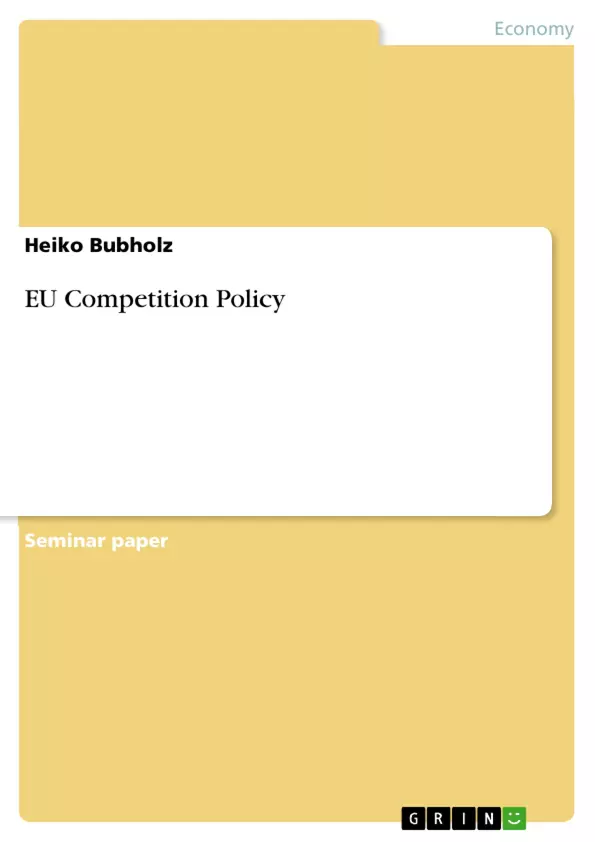All European Treaties express an attitude towards integration, which first time had been formulated and later on realised with the Schuman Plan. From that point on, the economic integration evolved to its today‘s magnitude in form of a Common Market and the historical move towards the implementation of €-currency in these days. The advantages of a Common Market had ever been understood regarding the potentially continuing and sustaining growth, guaranteeing a relatively high standard of living in wide area of the Member States of the European Union. Further, the existence of the integrated market may lead to a more or less homogenous and harmonic development of the relations of the Member States and the union’s periphery. The notion that unfair or restraining acts and behaviour will not go along with the liberal minded treaties, and will therefor be prohibited, may be found already in the Treaty of the European Coal and Steal Community (ECSC) from 1952. According to the Single European Act of 1986, an internal market shall be established, characterised by the free movement of goods and services, persons and capital. Article 10 of the TEU requests the Member States „to ensure fulfilment of the obligations arising out of this Treaty or resulting from action taken by the institutions of the Community”. Correspondingly, the Member States “shall abstain from any measure which could jeopardise the attainment of the objectives of this Treaty”. From these less restrictive formulations result some obligations for the Member States in order to assure a free market and liberal competition1. In contrast to some other but less “communised” field of European policies this is drawn to that extent that national competition regulation are supposed to be adapted, or even abolished, to ensure the jurisdictional unity and equality of competition throughout the European Union (EU) 2.
The foundation of European competition law results from Article 81 TEC (restriction of competition) and Article 82 TEC (abuse of dominating position). Article 83 to 89 TEC concern additional regulations, which might not be covered with this paper. According to EMMERICH and despite some more or less spectacular decisions made by the respective competition authorities one can hardly assert that a unique and workable European competition policy is in existence now3.
[...]
_____
1 Schmidt/Schmidt (1997), p. 3.
2 Zuleeg (1997), p. 129.
3 Emmerich (1994), p. 512.
Inhaltsverzeichnis (Table of Contents)
- Introduction
- Terminology and Definitions
- Goals of European Competition Policy
- Applicability of the European Competition Law and Policy
- EU Competition Policy
- Strategy of mediation
- Strategy of impediment
- Strategy of concentration
- European Competition Policy and Merger control (Fusionskontrolle)
- Critical issues of the European Competition Policy
Zielsetzung und Themenschwerpunkte (Objectives and Key Themes)
This document explores the evolution and application of European Competition Policy, aiming to provide an overview of its strategies, objectives, and key considerations. The focus is on understanding the role of competition policy in promoting a harmonized development within the European Union.
- The development and evolution of European Competition Policy
- The relationship between competition policy and economic integration
- The role of competition policy in achieving a common market
- The strategies employed by European competition authorities, including mediation, impediment, and concentration
- The challenges and critical issues related to implementing and enforcing European Competition Policy
Zusammenfassung der Kapitel (Chapter Summaries)
- Introduction: This chapter sets the context for the paper by outlining the historical development of European integration, particularly the Schuman Plan, the creation of the Common Market, and the move towards the Euro. It highlights the advantages of a Common Market and the need for competition policy to ensure fair and open trade within the European Union.
- Terminology and Definitions: This chapter defines key terms and goals related to European Competition Policy, emphasizing the need for a "pure" competition within the Common Market to achieve efficient resource allocation and international competitiveness. It also explores the tension between supranational competition policy and national industrial policy, particularly in the context of European Structural Policy.
- EU Competition Policy: This chapter delves into the strategies employed by European competition authorities: mediation, impediment, and concentration. It explores how these strategies are utilized to ensure fair and competitive market practices within the EU.
- European Competition Policy and Merger control (Fusionskontrolle): This chapter examines the specific application of European Competition Policy to mergers and acquisitions (Fusionskontrolle), highlighting how the policy is used to prevent the creation of monopolies and protect consumer interests.
- Critical issues of the European Competition Policy: This chapter discusses the challenges and complexities of implementing and enforcing European Competition Policy, exploring potential conflicts between national and supranational interests and the need for effective enforcement mechanisms.
Schlüsselwörter (Keywords)
This document explores the core concepts of European competition policy, including: Common Market, European integration, economic integration, competition law, mediation, impediment, concentration, merger control, and national competition policy. It also delves into the relationship between competition policy and industrial policy, highlighting key aspects of the European Union's economic strategy.
- Citar trabajo
- Heiko Bubholz (Autor), 2002, EU Competition Policy, Múnich, GRIN Verlag, https://www.grin.com/document/5544



